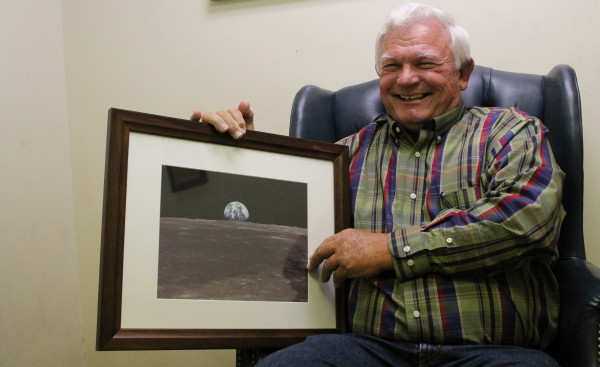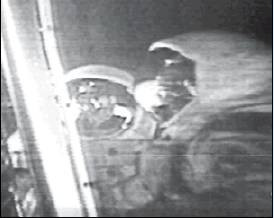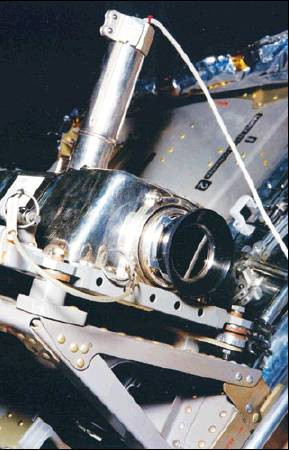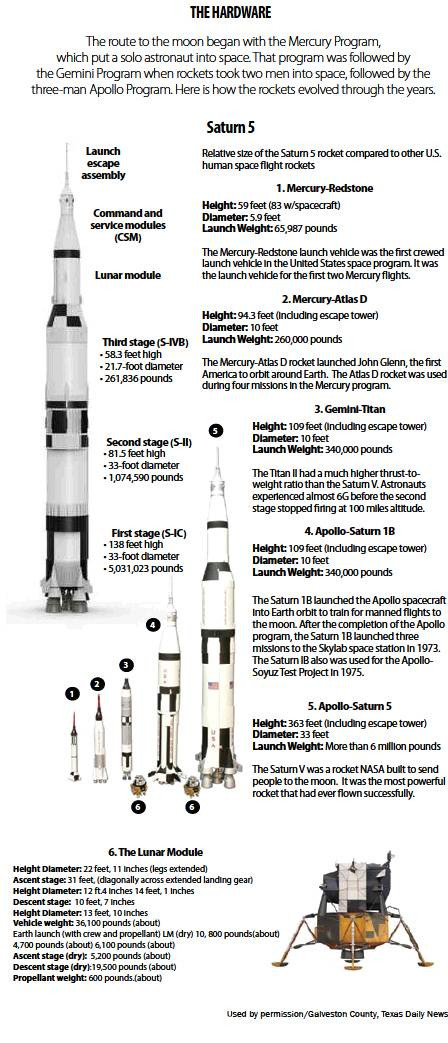Man on the moon

Leader photo by NANCY BERGERON
Ragan Edmiston holds a photograph of Earth rising over the moon’s surface. The picture was taken by the crew of Apollo 8, the first manned spacecraft to successfully orbit the moon and return to earth. “The first time they went around the moon, they looked at the horizon and saw the Earth rising,” he said. “Nobody had anticipated that.”

NASA archives photo
Restored footage of Buzz Aldrin and Neil Armstrong taken from the lunar module during the moon landing in 1969.

NASA photo
The Apollo lunar television camera, as it was mounted on the side of the Apollo 11 lunar module when it telecasted Armstrong’s one small step.

At best, the blackand-white video is grainy. One minute and 48 seconds into the broadcast, a spacesuited figure begins to descend a short ladder.
Hedraws his booted foot back to a platform that’s just out of the frame, then slowly extends his leg again, and with a small hop, plants both feet on the surface of the moon.
It’s July 20, 1969.
At the Houston headquarters of the National Aeronautics and Space Administration, Ragan Edmiston watched the otherworldly event on a television in his lab.
But the Lincoln Parish native wasn’t mesmerized by what he saw. He and his fellow NASA engineers were too busy looking to see if the equipment they developed for the lunar mission was functioning properly.
“As I saw each step happen, I thought, ‘Yeah, that worked like it was supposed to,’” Edmiston, now retired and living in Ruston, said. “It was much later that it finally came to me how out of this world (the Apollo 11 moonwalk) really was.”
Saturday, July 20, is the 50th anniversary of the mission that made Neil Armstrong and Buzz Aldrin the first human beings to walk on the moon. Armstrong was the first out the lunar module; Aldrin followed about 20 minutes later.
An estimated 650 million people watched Armstrong’s televised image and heard his voice describe “ … one small step for man, one giant leap for mankind.”
Edmiston was on the team of NASA engineers tasked with developing the television camera that sent the lunar images back to earth.
“The video that was sent back from the moon on Apollo 11 was the result of a great effort by not only NASA engineers but also some of the best television minds in American industries,” Edmiston said.
The primary objective of Apollo 11 was to meet President John F. Kennedy’s goal of landing a man on the moon and returning him safely to Earth before the decade of the 1960s ended.
Work on the lunar mission began while NASA was heavy in the single-man Mercury and two-man Gemini flights.
“The Mercury program and the Gemini program were the test beds for how to go to the moon,” Edmiston said.
Edmiston was a semester shy of graduating from Louisiana Tech University with an electrical engineering degree, “when the NASA guy showed up and offered me a most out-of-this world job: come to Houston and help put a man on the moon. They hired me on the spot.”
He finished school and on Feb. 12, 1962, and reported for duty at the age of 22.
It was the technical challenge of going to the moon that lured Edmiston to NASA.
“Realizing that nobody had ever done that before, it was right down my alley,” he said. “None of us knew how to go to the moon. We knew we had to figure out what we needed to know. We couldn’t lean on anybody.”
Edmiston was assigned to the communications group.
“One of the things we needed was a cap the astronauts could wear that would hold the headsets and the microphone in place,” Edmiston said. “Once you put the helmet on, you could not get in and move (the microphone).”
Loosely designed caps — they resembled hoods — meant the microphones over which astronauts communicated withMission Control, as well as the receivers through which they listened, could shift, leaving astronauts unable to communicate.
If that happened, “they would have to abort the mission,” Edmiston said.
Thus, the need for tightly fitting hoods, dubbed “Snoopy caps,” that held communications equipment steady once the helmet attached to the rest of the suit.
Because the Apollo astronauts would be venturing outside the spacecraft, ground controllers also needed a way to monitor the temperature, oxygen levels and other conditions inside the pressurized suits astronauts would wear.
So, Edmiston and his team developed a life support backpack that included a data link between the suit and ground control. He also worked on a radio that was part of the backpack.
NASA knew it wanted a television camera on the Apollo flights, but size, weight and power consumption were critical factors.
Early in the development of lunar module, the Grumman Corporation — the company building the craft — suggested removal of the TV camera, Edmiston said. Man could land on the moon without television, Grumman contended.
“Each time, Houston would rally around the great advantage of the camera, and it would be put back on,” Edmiston said. “Finally, Dr. Max Faget, the head NASA engineer, declared that we would have the camera on the moon landing, period.”
The finished product was smaller than a breadbox, weighed a little more than 7 pounds and used 10 watts of power, about the same amount used by one Christmas tree light.
It took four years to development the camera.
On Apollo 11, one camera was mounted inside the spacecraft cabin and another on the lunar excursion module pointing directly at the ladder Armstrong would descend. That was the camera that caught the images broadcast worldwide.
Apollo 11 launched from Cape Kennedy on July 16, 1969. On July 18, Armstrong and Aldrin put on their spacesuits and moved through a docking tunnel from the Columbia spacecraft to the lunar module, named the Eagle, to check it over.
By design, the Eagle’s skin was so thin, you could have poked a hole in it with your finger, Edmiston said.
“It was made of the lightest, thinnest stuff possible,” he said.
On July 19, came the first lunar orbit intersection. On July 20, Armstrong and Aldrin entered the Eagle again, separated from Columbia and begin to make their descent to the surface of the moon.
But the overloaded onboard computer failed, forcing Armstrong to manually pilot the Eagle away from a rocky area to which it was headed to a soft landing spot.
“When he landed, he had about 10 to 15 seconds of fuel left,” Edmiston said.
Edmiston said he realizes that in 1969 he was “too close to the forest to see” the magnitude of putting a man on the moon. The young engineers — their average age was 29 — were just going to work everyday to pound away at their assignment.
“I have a lot more respect today for what we did than I did then,” he said. “As I got older and looked back, I realized the amount of things that had to be developed and fitted together was just amazing.”
Edmiston retired from NASA in 1998. He never had any desire to be an astronaut. Americans will eventually go back to the moon, he predicted, “if we can keep this nation viable — keep technology what it should be.”
And on the 50th anniversary of mission in which he had a hand, Edmiston smiles and said he wonders where the years have gone.
He wants people to realize “how important the space program was, not only to the Americans, but to the whole world, and that the meaning of that will hopefully lead us back to being more active in space.”
“Everybody got a good feeling from us being on the moon,” Edmiston said. “It probably drew more people in the world closer than anything human beings had ever done before. It just seemed so impossible.”

